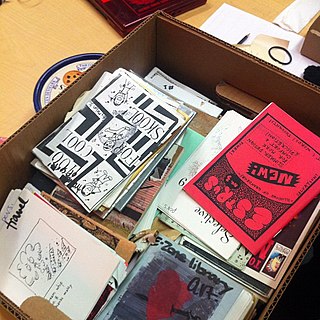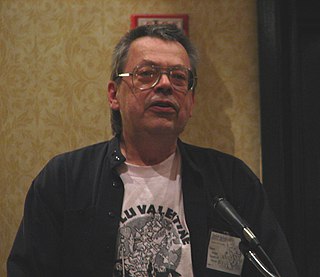
A fanzine is a non-professional and non-official publication produced by enthusiasts of a particular cultural phenomenon for the pleasure of others who share their interest. The term was coined in an October 1940 science fiction fanzine by Russ Chauvenet and first popularized within science fiction fandom, and from there the term was adopted by other communities.

Science fiction fandom or SF fandom is a community or fandom of people interested in science fiction in contact with one another based upon that interest. SF fandom has a life of its own, but not much in the way of formal organization.

A zine is a small-circulation self-published work of original or appropriated texts and images, usually reproduced via a copy machine. Zines are the product of either a single person or of a very small group, and are popularly photocopied into physical prints for circulation. A fanzine is a non-professional and non-official publication produced by enthusiasts of a particular cultural phenomenon for the pleasure of others who share their interest. The term was coined in an October 1940 science fiction fanzine by Russ Chauvenet and popularized within science fiction fandom, entering the Oxford English Dictionary in 1949.

A science-fiction fanzine is an amateur or semi-professional magazine published by members of science-fiction fandom, from the 1930s to the present day. They were one of the earliest forms of fanzine, within one of which the term "fanzine" was coined, and at one time constituted the primary type of science-fictional fannish activity ("fanac").
File 770 is a long-running science fiction fanzine, newszine, and blog site published and administered by Mike Glyer. It has been published every year since 1978, and has won a record eight Hugo Awards for Best Fanzine, with the first win in 1984 and the latest in 2018.
Harry Warner Jr. was an American journalist. He spent 40 years working for the Hagerstown, Maryland, Herald-Mail.

Theodore Edwin White is a Hugo Award-winning American science fiction writer, editor and fan, as well as a music critic. He writes and edits as Ted White. In addition to books and stories written under his own name, he has also co-authored novels with Dave van Arnam as Ron Archer, and with Terry Carr as Norman Edwards.

David A. Kyle was an American science fiction writer and member of science fiction fandom.

Stephen Willis Stiles was an American cartoonist and writer, coming out of the science fiction fanzine tradition. He won the 2016 Hugo Award for Best Fan Artist.

The 61st World Science Fiction Convention (Worldcon), also known as Torcon 3, was held on 28 August–1 September 2003 at the Metro Toronto Convention Centre and the Fairmont Royal York and Crowne Plaza hotels in Toronto, Ontario, Canada.

Janus was a feminist science fiction fanzine edited by Janice Bogstad and Jeanne Gomoll in Madison, Wisconsin, and closely associated with that city's science fiction convention, WisCon. It was repeatedly nominated for the Hugo Award for Best Fanzine ; this led to accusations that if Janus had not been feminist, it wouldn't have been nominated. Eighteen issues were published under this name from 1975 to 1980; it was succeeded by Aurora SF.

The 56th World Science Fiction Convention (Worldcon), also known as BucConeer, was held on 5–9 August 1998 at the Baltimore Convention Center, the Baltimore Marriott Inner Harbor, the Holiday Inn Inner Harbor, the Omni Inner Harbor Baltimore, and the Baltimore Hilton and Towers in Baltimore, Maryland, United States.

The 23rd World Science Fiction Convention (Worldcon), also known as Loncon II, was held on 27–30 August 1965 at the Mount Royal Hotel in London, United Kingdom. It was the second Worldcon to be held in London, following the original Loncon in 1957.
The 50th World Science Fiction Convention (Worldcon), also known as MagiCon, was held on 3–7 September 1992 at the Clarion Hotel, The Peabody Orlando, and the Orange County Convention Center in Orlando, Florida, United States.
The 52nd World Science Fiction Convention (Worldcon), also known as ConAdian, was held on 1–5 September 1994 at the Crowne Plaza, Place Louis Riel, and Sheraton hotels, and the Winnipeg Convention Centre in Winnipeg, Manitoba, Canada.

The 55th World Science Fiction Convention (Worldcon), also known as LoneStarCon 2, also known as "The Second Occasional LoneStarCon Science Fiction Convention & Chili Cook-off", was held on 28 August–1 September 1997 at the Marriott Rivercenter, Marriott Riverwalk, and the Henry B. Gonzalez Convention Center in San Antonio, Texas, United States. The first LoneStarCon, held in Austin, Texas, had been the North American Science Fiction Convention (NASFiC) in 1985, when the 43rd Worldcon was held in Australia.
The 51st World Science Fiction Convention (Worldcon), also known as ConFrancisco, was held on 2–6 September 1993 at the ANA Hotel, Parc Fifty Five, and Nikko Hotels and the Moscone Convention Center in San Francisco, California, United States.
Hyphen was an Irish science fiction fanzine, published from 1952-1965 by Walt Willis in collaboration with James White, Bob Shaw and various others. Over that period, they published 36 issues. In addition, a 37th issue was created by the Willises in 1987 to celebrate the 40th anniversary of Irish science fiction fandom.
Jeanne Gomoll is an American artist, writer, editor, and science fiction fan, who was recognized as one of the guests of honor at the 72nd World Science Fiction Convention, having been a guest of honor at numerous previous science fiction conventions. She has been nominated multiple times for awards in artist and fanzine categories, and for service to the genre of science fiction, particularly feminist science fiction.

Futuria Fantasia was an American science fiction fanzine created by Ray Bradbury in 1938, when he was 18 years old. Though only four issues of the fanzine were published, its list of contributors included Hannes Bok, Forrest J. Ackerman, Henry Kuttner, Damon Knight, and Robert A. Heinlein.












